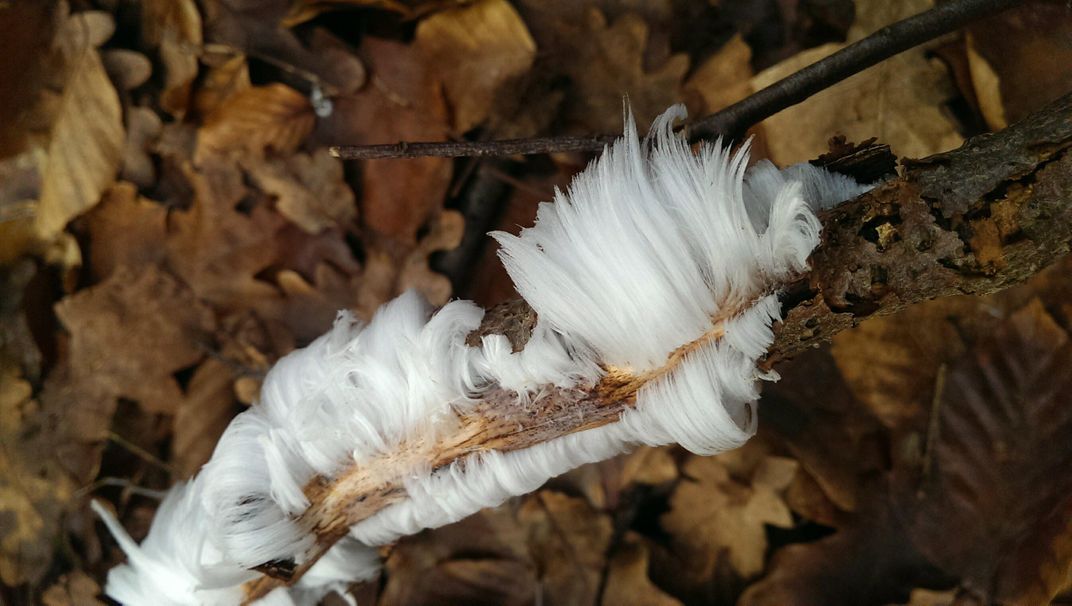The Wintertime Wonder of Unusual Ice
Rime ice in the Midwest and hair ice in the United Kingdom have people wondering: Why does ice do that?
/https://tf-cmsv2-smithsonianmag-media.s3.amazonaws.com/filer/95/f2/95f2447d-9e01-4540-87e8-b8465f0d681c/jan6_rimeice.jpg)
After several days of foggy, cold weather, a thick layer of spiky white ice decorated landscapes across Minnesota, Iowa and Wisconsin. Meanwhile, in the United Kingdom, several humid nights around freezing temperatures led people to find cotton candy-like ice sprouting from rotting wood.
Ice can take many wild and whacky forms depending on the conditions that create it—from slick, dangerous black ice on pavement to perfectly round ice circles on the surfaces of rivers. The bristly ice coating tree branches in the Midwest is called rime ice, which is essentially just a buildup of frozen water droplets. The fluffy ice formations spotted in the United Kingdom are called hair ice, and they’re created with the help of a fungus.

Rime ice is not a rare phenomenon, but it doesn’t usually build up over several days, says meteorologist John Gagan to Joe Taschler at the Milwaukee Journal Sentinel. Foggy weather means that the landscape was immersed in water droplets suspended in the air. When those droplets hit a surface that’s at a below-freezing temperature, the water freezes, too.
Rime ice can form in a couple of ways. It can be a dense buildup of ice, called hard rime, or a fragile layer of snowflake-like frost spikes, called soft rime. Its spiky appreance often gets mistaken for hoarfrost, a better-known form of ice. Hoarfrost forms when water vapor, the gaseous form of water, freezes onto surfaces. That means it skips over the liquid phase and goes straight from gas to solid, Kalie Pluchel explains for KCRG in Cedar Rapids, Iowa.
The result of all of that buildup is near-magical scenes of winter wonderlands.
In other news, Holy Hill is surrounded in rime ice. Here’s what rime ice is, and some more cool pics: #RimeIce #wiwx #ice #holyHill https://t.co/n1x24Frdp8 pic.twitter.com/NCKk90OMU0
— Mike De Sisti (@mdesisti) January 5, 2021
But rime ice can cause damage, too. When water droplets in clouds or fog freeze into rime ice onto the outside of airplanes, the resulting bumpy surface can interfere with airflow across the wings.
"This is a very big issue for aviation. This is what can happen when you are flying up in the clouds," says Gagan to the Milwaukee Journal Sentinel. "So that's why they have a lot of deicing mechanisms on planes to prevent this from happening because it does mess with aerodynamics."
Over the last few days, people have shared pictures of rime ice from all over the country.
The strange ice that appeared in the United Kingdom needs a little help to form into its distinctive toupee-like shape. Hair ice looks like a mop of delicate icy tendrils that grow out of rotten wood. It forms overnight and melts away once it’s hit by sunlight. The distinctive shape comes about thanks to help from a mushroom called Exidiopsis effusa.
Scientists identified the mushroom as the cause of hair ice in 2015, Melissa Hogenboom reported for BBC News at the time. Something in the fungus, such as a recrystallization inhibitor, makes it so that as water moves through the organism on humid nights, it solidifies into long ice “hairs” that are just a hundredth of a millimeter in diameter. By early morning, before sunlight peaks through, it looks like rotten branches and leaf litter are wearing snow-white wigs.
Recently, hair ice, which is also called frost flowers, has been spotted in Ireland and Scotland, Julian Fowler reports for BBC News.

